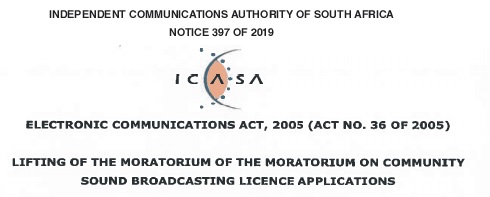High-demand radio frequency spectrum:
Cabinet has approved the text of the long-awaited spectrum policy direction:
B. Cabinet decisions
1. Policy and Policy Direction for the Licensing of the High Demand Spectrum
1.1. Cabinet approved the Policy and Policy Direction for the Licensing of the High Demand Spectrum after extensive consultations with the sector and the public. The Policy and Policy Direction sets a framework for the transformation of the sector by enabling entrance of new players in this important market while at the same time encouraging investments and innovation. The Minister of Communications and Digital Technologies, Ms Stella Ndabeni-Abrahams, will in the next few days issue the Cabinet approved the final policy and brief the media.
In an explanation of the Department of Communications’ position, minister of communications Stella Ndabeni-Abrahams said that much of the high demand spectrum will be assigned to a Wholesale Open Access Network (WOAN).
This is in line with changes made to the Electronic Communications Act (ECA) in the Government Gazette published at the end of 2018.
Once this spectrum has been assigned to the WOAN, the remaining high demand spectrum may be assigned to other electronic communications network service licensees, Ndabeni-Abrahams said.
The document does not specify how much spectrum will be given to the WOAN and how much will be given to network operators.
WOAN
According to the document, the WOAN must have the following conditions attached:
- It must be a consortium of persons, at least 70% owned by South Africans, that participate voluntarily;
- It must comply with the empowerment requirements contemplated in section 9(2)(b) of the ECA;
- It must include diversity of ownership to ensure meaningful participation of all entities involved including SMMEs, and °o prevent monopolistic behaviour;
- It must include effective participation by targeted groups, including women, youth and persons with disabilities; and
- It may include public entities as shareholders provided that the WOAN may not be a public entity, under the Public Finance Management Act.
Non-WOAN assignment
According to the document, the assignment of high demand spectrum not reserved for assignment to the WOAN must ensure that the following policy objectives are achieved:
- Leasing of electronic communications networks and electronic communications facilities and provision of wholesale capacity to other licensees, including to the WOAN upon request, as soon as the WOAN is licensed. The Authority must perform strict regulatory oversight to ensure compliance with this network and facilities leasing requirement;
- Universal access and universal service obligations to ensure high-quality network availability in rural and under-serviced areas;
- The obligations must be complied with in rural and under -serviced areas before the assigned spectrum may be used it other areas bearing in mind practicalities such as the unsuitability of certain high band spectrum for rural areas;
- A single entity may not control the spectrum;
- Compliance with empowerment requirements.
5G spectrum
These conditions are largely in line with the above-mentioned Electronic Communications Amendment Act published last year.
The one notable difference is the consideration of 5G spectrum which Ndabeni-Abrahams said would be covered in a separate policy directive sometime in 2020.
“The authority is directed to investigate and report to the Minister on the spectrum requirements of 5G in bands lower than 6 GHz and the millimetre wave (mmW) bands currently under study at the 2019 World Radio Communication Conference (WRC -19),” the department said. WRC -19 takes place from 28 October – 22 November 2019 in Sharm el-Sheikh in Egypt, which means the report is likely to be produced by 22 May 2020.
The report should be provided to the minister within six months after the WRC -19. The investigation should cover the affected bands, the required ecosystem to support 5G in these bands, and the implications of the licensing of these bands on competition and the current structure of the mobile market.
To this extent, the licensing of the 5G candidate bands will be informed by the outcome of the aforementioned investigation and report from the Authority. The Minister will thereafter, issue a separate policy direction on the 5G candidate bands,
Additional 5G spectrum is unlikely to be given to mobile operators anytime soon.
Ndabeni-Abrahams directed ICASA to investigate and report to the Minister on the spectrum requirements of 5G in bands lower than 6GHz and the millimetre wave (mmW) bands.
The investigation should cover the affected bands, the required ecosystem to support 5G in these bands, and the implications of the licensing of these bands.
The minister said this report should be provided to her within six months after the 2019 World Radiocommunication Conference (WRC -19).
WRC -19 takes place from 28 October – 22 November 2019 in Sharm el-Sheikh in Egypt, which means the report is likely to be produced by 22 May 2020.
The minister said the licensing of the 5G candidate bands will be informed by the outcome of the ICASA investigation and report. She will thereafter issue a separate policy direction on the 5G candidate bands.
What does this mean for 5G in South Africa?
In short, this means that mobile operators will not get any additional 5G spectrum this year.
Rapid 5G deployments in South Africa is unlikely as the launch of commercial 5G services may be delayed for any telecoms companies WHICH DO NOT ALREADY HAVE 5G SPECTRUM.
Rain has 148MHz spectrum in the 3.6GHz band – significantly more spectrum that what it has in the 1,800MHz and 2.6GHz bands. Vodacom is in discussions with Rain and Liquid Telecom to enable it to launch 5G products in South Africa when commercial 5G routers become available. According to Rain this will happen in September 2019 with Rain’s public 5G launch. Liquid has 56MHz of spectrum in the 3.5GHz band — at 3 456MHz to 3 484MHz and 3 556MHz to 3 584MHz. The only other operators with access to this band are Telkom and Rain.
Is Rain using a satellite spectrum for its 5G Network in South Africa?
Sources:
https://mybroadband.co.za/news/cellular/314627-bad-news-for-5g-in-south-africa.html

